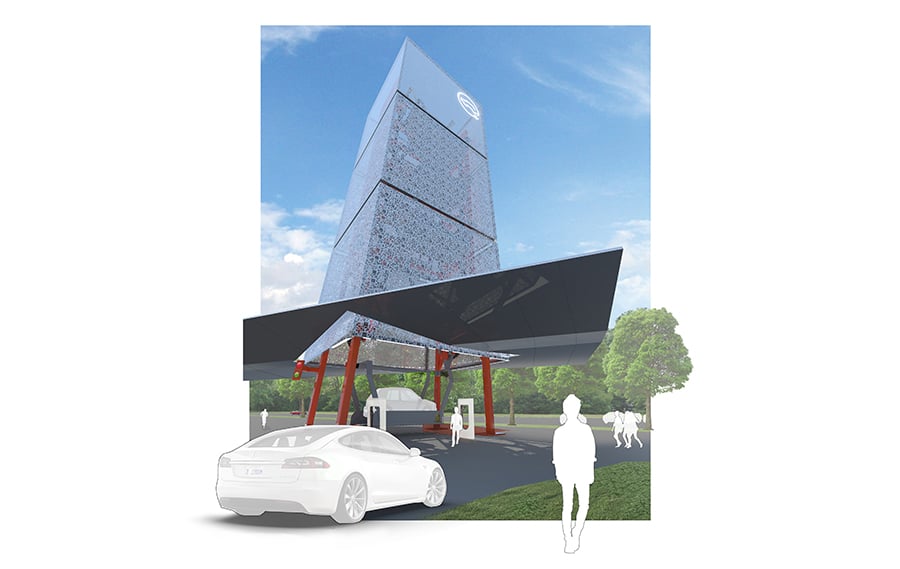
April 3, 2017
What if…The Electric Car Turned Gas Stations Into Civic Beacons?
With the continuing evolution of both electric and driverless car technologies, might we be in store for a new golden age of “roadside” architecture and infrastructural design?
With the continuing evolution of both electric and driverless car technologies, might we be in store for a new golden age of “roadside” architecture and infrastructural design? Contemporary developments in transportation technology are now changing how we drive, store, and power vehicles. What opportunities do these new technologies represent for design and its impact on the relationship between car, driver, and city?


Unlike filling up a car at a gas station, charging an electric car currently takes a larger investment of time from the driver. At present, there are two primary options for charging an electric vehicle: a super charge or a standard charge. A super charge utilizes both alternating and direct current simultaneously to provide a vehicle with over 100 miles of charge in only 25 minutes. Such a system is best used by drivers who are still on their way to their destination or need the extra miles to get home. The standard charge method takes up to five hours to achieve the same level of charge. While many electric car owners charge their vehicle at night while at home, drivers sometimes need to find a re-charge while out in the city. This begs the question: what should drivers do while they are, in essence, a captive audience?
This question is an incredible opportunity to re-think the “gas station” as an essential and contributing component of our communities… as a true civic space. Assuming that drivers would be looking to be entertained, fed, and/or placated while their car is charging, would this not be an incredible commercial and cultural opportunity? Store owners and developers would certainly find value in this proposition, but could museums and other cultural venues see opportunity in sites filled with such a captive, public audience? I believe it is a rare design opportunity when we know that people are guaranteed to be at a given location for a set amount of time.
As part of this larger conversation, our Ennead Lab team was asked to develop a concept for an electric car charging station for a site currently zoned for a gas station in a new urban development in Shanghai. In order to accommodate both a small, urban, pedestrian-friendly site and to maximize the number of cars that can simultaneously utilize a standard charging system, we combined existing charger technologies with existing stack-parking technologies to create a Charging Tower. At the ground level, “super-charge” stations are housed beneath a light-weight canopy. The parking towers above are clad in a reflective, perforated metal, creating a beacon for those searching for parking and car charging.


This is not a new idea. Rather, it combines two existing technologies to create a new typology of charging station (in the case of its parking technology, the design utilizes a century-old method for stacking cars on a vertical carousel—see the images above). In particular, the design confronts the challenge of the charging station in dense urban areas, where the horizontal configuration of most existing stations simply can’t support a large number of cars within a small footprint. As more electric cars enter the market and traverse our roads, the need for additional charging locations will increase. For cities and other sites of dense car traffic (such as rest stops, major interstate exchanges,etc.), a vertical solution is likely necessary.
This prototype envisions the “gas station” of the future as an integral component of new urban and suburban developments, giving drivers access to shopping, recreation, and culture while they re-charge their cars. It creates an architectural statement that reflects the cutting-edge nature of these new automotive technologies and elevates this typology to a true piece of civic infrastructure: an architectural beacon that recalls the optimism of earlier automotive “roadside” designs.
Andrew Burdick is an architect and design activist. He is an Associate Partner at Ennead Architects and the Director of Ennead Lab, the firm’s research and design advocacy initiative. This series—titled What If…?—focuses on design opportunities and their potential impact.
Recent Viewpoints
Viewpoints
Sustainability News Updates for Q2 2025









